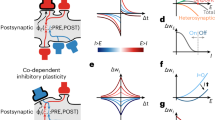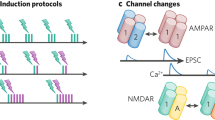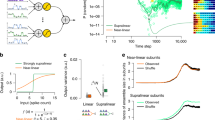Abstract
The rules by which neuronal activity causes long-term modification of synapses in the central nervous system are not fully understood. Whereas competitive or correlation-based rules result in local modification of synapses, homeostatic modifications allow neuron-wide changes in synaptic strength, promoting stability1,2. Experimental investigations of these rules at central nervous system synapses have relied generally on manipulating activity in populations of neurons1,3,4,5,6. Here, we investigated the effect of suppressing excitability in single neurons within a network of active hippocampal neurons by overexpressing an inward-rectifier potassium channel. Reducing activity in a neuron before synapse formation leads to a reduction in functional synaptic inputs to that neuron; no such reduction was observed when activity of all neurons was uniformly suppressed. In contrast, suppressing activity in a single neuron after synapses are established results in a homeostatic increase in synaptic input, which restores the activity of the neuron to control levels. Our results highlight the differences between global and selective suppression of activity, as well as those between early and late manipulation of activity.
This is a preview of subscription content, access via your institution
Access options
Subscribe to this journal
Receive 51 print issues and online access
$199.00 per year
only $3.90 per issue
Buy this article
- Purchase on Springer Link
- Instant access to full article PDF
Prices may be subject to local taxes which are calculated during checkout




Similar content being viewed by others
References
Turrigiano, G. G. & Nelson, S. B. Hebb and homeostasis in neuronal plasticity. Curr. Opin. Neurobiol. 10, 358–364 (2000)
Abbott, L. F. & Nelson, S. B. Synaptic plasticity: taming the beast. Nature Neurosci. 3 Suppl., 1178–1183 (2000)
Katz, L. C. & Shatz, C. J. Synaptic activity and the construction of cortical circuits. Science 274, 1133–1138 (1996)
Rao, A. & Craig, A. M. Activity regulates the synaptic localization of the NMDA receptor in hippocampal neurons. Neuron 19, 801–812 (1997)
Turrigiano, G. G., Leslie, K. R., Desai, N. S., Rutherford, L. C. & Nelson, S. B. Activity-dependent scaling of quantal amplitude in neocortical neurons. Nature 391, 892–896 (1998)
Liao, D., Zhang, X., O'Brien, R., Ehlers, M. D. & Huganir, R. L. Regulation of morphological postsynaptic silent synapses in developing hippocampal neurons. Nature Neurosci. 2, 37–43 (1999)
Sanes, J. R. & Lichtman, J. W. Development of the vertebrate neuromuscular junction. Ann. Rev. Neurosci. 22, 389–442 (1999)
Crowley, J. C. & Katz, L. C. Development of ocular dominance columns in the absence of retinal input. Nature Neurosci. 2, 1125–1130 (1999)
Hubener, M. & Bonhoeffer, T. Eyes wide shut. Nature Neurosci. 2, 1043–1045 (1999)
Lin, D. M. et al. Formation of precise connections in the olfactory bulb occurs in the absence of odorant-evoked neuronal activity. Neuron 26, 69–80 (2000)
Zheng, C., Feinstein, P., Bozza, T., Rodriguez, I. & Mombaerts, P. Peripheral olfactory projections are differentially affected in mice deficient in a cyclic nucleotide-gated channel subunit. Neuron 26, 81–91 (2000)
Zhao, H. & Reed, R. R. X inactivation of the OCNC1 channel gene reveals a role for activity-dependent competition in the olfactory system. Cell 104, 651–660 (2001)
Luscher, C., Nicoll, R. A., Malenka, R. C. & Muller, D. Synaptic plasticity and dynamic modulation of the postsynaptic membrane. Nature Neurosci. 3, 545–550 (2000)
Bi, G. Q. & Poo, M. M. Synaptic modification by correlated activity: Hebb's postulate revisited. Ann. Rev. Neurosci. 24, 139–166 (2001)
Davis, G. W. & Bezprozvanny, I. Maintaining the stability of neural function: a homeostatic hypothesis. Annu. Rev. Physiol. 63, 847–869 (2001)
Johns, D. C., Marx, R., Mains, R. E., O'Rourke, B. & Marban, E. Inducible genetic suppression of neuronal excitability. J. Neurosci. 19, 1691–1697 (1999)
Holt, J. R. et al. Functional expression of exogenous proteins in mammalian sensory hair cells infected with adenoviral vectors. J. Neurophysiol. 81, 1881–1888 (1999)
Xia, Z., Dudek, H., Miranti, C. K. & Greenberg, M. E. Calcium influx via the NMDA receptor induces immediate early gene transcription by a MAP kinase/ERK-dependent mechanism. J. Neurosci. 16, 5425–5436 (1996)
Craig, A. M., Blackstone, C. D., Huganir, R. L. & Banker, G. Selective clustering of glutamate and GABA receptors opposite synaptic terminals releasing the corresponding neurotransmitters. Proc. Natl Acad. Sci. USA 91, 12373–12377 (1994)
O'Brien, R. J. et al. The development of excitatory synapses in cultured spinal neurons. J. Neurosci. 17, 7339–7350 (1997)
Gomperts, S. N., Carroll, R., Malenka, R. C. & Nicoll, R. A. Distinct roles for ionotropic and metabotropic glutamate receptors in the maturation of excitatory synapses. J. Neurosci. 20, 2229–2237 (2000)
Cottrell, J. R., Dube, G. R., Egles, C. & Liu, G. Distribution, density, and clustering of functional glutamate receptors before and after synaptogenesis in hippocampal neurons. J. Neurophysiol. 84, 1573–1587 (2000)
Balice-Gordon, R. J. & Lichtman, J. W. Long-term synapse loss induced by focal blockade of postsynaptic receptors. Nature 372, 519–524 (1994)
Betz, W. J. & Bewick, G. S. Optical analysis of synaptic vesicle recycling at the frog neuromuscular junction. Science 255, 200–203 (1992)
Li, Z. & Murthy, V. N. Visualizing post-endocytic traffic of synaptic vesicles at hippocampal synapses. Neuron 31, 593–605 (2001)
Murthy, V. N., Schikorski, T., Stevens, C. F. & Zhu, Y. Inactivity produces increases in neurotransmitter release and synapse size. Neuron 32, 673–682 (2001)
Bacci, A. et al. Chronic blockade of glutamate receptors enhances presynaptic release and downregulates the interaction between synaptophysin-synaptobrevin-vesicle-associated membrane protein 2. J. Neurosci. 21, 6588–6596 (2001)
Paradis, S., Sweeney, S. T. & Davis, G. W. Homeostatic control of presynaptic release is triggered by postsynaptic membrane depolarization. Neuron 30, 737–749 (2001)
Liao, D., Hessler, N. A. & Malinow, R. Activation of postsynaptically silent synapses during pairing-induced LTP in CA1 region of hippocampal slice. Nature 375, 400–404 (1995)
Isaac, J. T. R., Nicoll, R. A. & Malenka, R. C. Evidence for silent synapses: implications for the expression of LTP. Neuron 15, 427–434 (1995)
Acknowledgements
We thank E. Marban for the gift of the EGFP–IRES–Kir2.1 construct. We also thank the members of our laboratory for discussion. This work was supported by grants from the National Institutes of Health and the NSF. V.N.M. is a Sloan Foundation Fellow, a Pew Scholar, an EJLB Foundation Scholar and a National Alliance for Research on Schizophrenia and Depression (NARSAD) Young Investigator. J.B. is a Grable Investigator of NARSAD.
Author information
Authors and Affiliations
Corresponding author
Ethics declarations
Competing interests
The authors declare that they have no competing financial interests.
Rights and permissions
About this article
Cite this article
Burrone, J., O'Byrne, M. & Murthy, V. Multiple forms of synaptic plasticity triggered by selective suppression of activity in individual neurons. Nature 420, 414–418 (2002). https://doi.org/10.1038/nature01242
Received:
Accepted:
Issue Date:
DOI: https://doi.org/10.1038/nature01242
This article is cited by
-
GluN2A mediates ketamine-induced rapid antidepressant-like responses
Nature Neuroscience (2023)
-
Emerging strategies for the genetic dissection of gene functions, cell types, and neural circuits in the mammalian brain
Molecular Psychiatry (2022)
-
Synergistic effects of common schizophrenia risk variants
Nature Genetics (2019)
-
Homeostatic plasticity in neural development
Neural Development (2018)
-
Pyramidal cell regulation of interneuron survival sculpts cortical networks
Nature (2018)
Comments
By submitting a comment you agree to abide by our Terms and Community Guidelines. If you find something abusive or that does not comply with our terms or guidelines please flag it as inappropriate.



